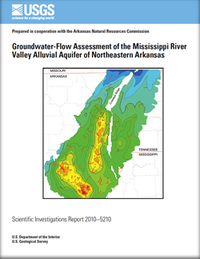The Mississippi River Valley alluvial aquifer is a water-bearing assemblage of gravels and sands that underlies about 32,000 square miles of Arkansas, Kentucky, Louisiana, Mississippi, Missouri, and Tennessee. Pumping of groundwater from the alluvial aquifer for agriculture started in the early 1900s in the Grand Prairie area for the irrigation of rice and soybeans. From 1965 to 2005, water use in the alluvial aquifer increased 655 percent. In 2005, 6,242 million gallons per day of water were pumped from the aquifer, primarily for irrigation and fish farming. Water-level declines in the alluvial aquifer were documented as early as 1927. Long-term water-level measurements in the alluvial aquifer show an average annual decline of 1 foot per year in some areas.
In this report, the utility of the updated 2009 MODFLOW groundwater-flow model of the alluvial aquifer in northeastern Arkansas was extended by performing groundwater-flow assessments of the alluvial aquifer at specific areas of interest using a variety of methods. One such area is along the western side of Crowleys Ridge, which includes western parts of Clay, Greene, Craighead, Poinsett, Cross, St. Francis, and Lee Counties. This area was designated as the Cache Critical Groundwater Area by the Arkansas Natural Resources Commission in 2009 for the alluvial and Sparta/Memphis aquifers, because of the rate of change in groundwater levels and groundwater levels have dropped below half the original saturated thickness of the alluvial aquifer.


